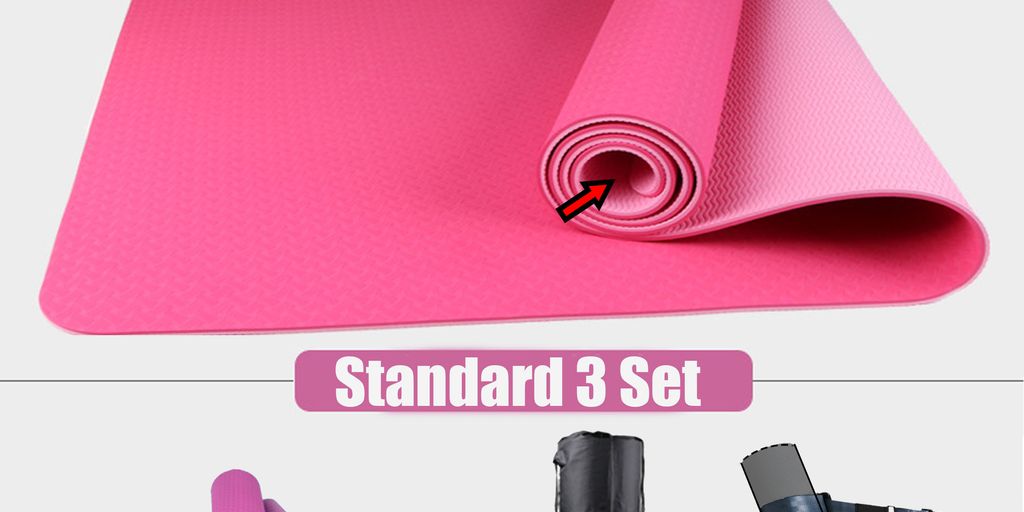
Finding the Best Yoga Mat: A Comprehensive Guide to Your Perfect Practice Partner
Choosing the right yoga mat can make a big difference in your practice. With so many options out there, it can be hard to find the perfect one. This guide will help you understand the different types of mats, what to look for, and how to care for your mat. Whether you're a beginner or a seasoned yogi, you'll find useful tips here.
Key Takeaways
- Different mats are made from different materials like rubber, PVC, and cork. Each has its own benefits.
- The thickness of a mat affects its cushioning. Thicker mats offer more comfort, while thinner mats provide better balance.
- Texture and grip are important for stability. Some mats have a sticky feel, while others are smooth.
- Consider your yoga style when choosing a mat. For example, hot yoga might require a mat with better grip.
- Eco-friendly mats are available for those who want to reduce their environmental impact.
Understanding Different Types of Yoga Mats
Material Varieties
Yoga mats come in a range of materials, each offering unique benefits. PVC mats are durable and provide excellent grip, but they are not eco-friendly. TPE mats are a more environmentally friendly option, offering good traction and cushioning. Natural rubber mats are another popular choice, known for their excellent grip and eco-friendliness, though they can be heavier and have a distinct smell.
Thickness and Cushioning
The thickness of a yoga mat can greatly affect your practice. Mats typically range from 1/16 inch to 1/4 inch thick. Thinner mats (1/16 inch) are great for stability and balance, making them ideal for more dynamic styles of yoga. Thicker mats (1/4 inch) provide more cushioning, which is beneficial for restorative or therapeutic practices.
Texture and Grip
The texture of a yoga mat affects its grip and how much you might slip during practice. Some mats have a natural stickiness, while others have a raised, tactile pattern. A mat with good grip is essential for maintaining poses, especially in styles like hot yoga where you might sweat a lot. If you prefer a smoother surface, look for mats with a non-slip coating.
Factors to Consider When Choosing a Yoga Mat
Your Yoga Style
Different yoga styles require different types of mats. For example, if you practice hot yoga, you'll need a mat with excellent grip and sweat absorption. On the other hand, a thicker mat might be better for gentle yoga styles to provide more cushioning.
Portability and Weight
If you travel often or like to take your mat to classes, consider its weight and how easy it is to carry. Lightweight mats are easier to transport but may offer less cushioning.
Eco-Friendliness
Many people prefer mats made from eco-friendly materials like natural rubber or jute. These mats are not only better for the environment but also often have a better grip and durability.
Choosing the right yoga mat can make a big difference in your practice. Make sure to consider these factors to find the perfect mat for your needs.
Top Brands for the Best Yoga Mats
Liforme
Liforme is known for its eco-friendly mats that offer excellent grip and alignment guides. These mats are made from biodegradable materials, making them a great choice for environmentally conscious yogis. Liforme mats are often praised for their durability and comfort.
Manduka
Manduka mats are popular for their high-density cushioning and long-lasting quality. They are designed to withstand intense practice sessions and provide superior support. The Pro Series by Manduka is especially favored by professional yogis for its non-slip surface and lifetime guarantee.
Jade Yoga
Jade Yoga mats are made from natural rubber, providing a non-toxic and eco-friendly option. These mats are known for their exceptional grip and comfort. Jade Yoga also plants a tree for every mat sold, making it a brand that gives back to the environment.
Choosing the right yoga mat brand can significantly enhance your practice, offering the perfect balance of comfort, support, and sustainability.
How to Maintain and Clean Your Yoga Mat
Keeping your yoga mat clean is essential for both hygiene and longevity. Here’s how you can maintain and clean your mat effectively.
Cleaning Techniques
Regular cleaning of your yoga mat is crucial. Use a soft cloth to wipe down your mat after each session. A spray bottle filled with a homemade solution can help you spray evenly for both regular wipe-downs and spot-cleaning. For a deeper clean, you can soak your mat in a bathtub with mild soap and water, then rinse thoroughly.
Storage Tips
Proper storage can extend the life of your yoga mat. Always roll your mat up loosely and store it in a cool, dry place. Avoid leaving it in direct sunlight or in the trunk of your car, as extreme temperatures can damage the material.
When to Replace Your Mat
Even with the best care, yoga mats don’t last forever. If you notice wear and tear, such as thinning or loss of grip, it might be time to invest in a new one. Generally, a good-quality mat should last about a year with regular use.
Taking care of your yoga mat not only ensures a clean practice but also helps you get the most out of your investment.
Budget-Friendly Options for Quality Yoga Mats
Affordable Brands
Finding a good yoga mat doesn't have to break the bank. There are several brands that offer quality mats at a lower price. Gaiam and BalanceFrom are two popular choices that provide durable and comfortable mats without costing too much.
DIY Yoga Mats
If you're feeling crafty, you can make your own yoga mat. Using materials like old blankets or towels, you can create a mat that suits your needs. This not only saves money but also allows for a personalized touch.
Sales and Discounts
Keep an eye out for sales and discounts, especially during holiday seasons or special events. Many stores and online shops offer significant markdowns on yoga mats. Signing up for newsletters from your favorite brands can also alert you to upcoming deals.
Investing in a budget-friendly yoga mat doesn't mean you have to compromise on quality. With a little research and creativity, you can find the perfect mat for your practice without spending a fortune.
Specialty Yoga Mats for Unique Needs
Travel-Friendly Mats
For yogis on the go, travel-friendly mats are a must. These mats are lightweight and easy to fold, making them perfect for packing in a suitcase. They offer convenience without sacrificing quality. Look for mats that are thin yet durable, providing enough grip and cushioning for your practice.
Extra Long and Wide Mats
If you need more space during your practice, extra long and wide mats are the way to go. These mats provide additional room for stretching and moving, ensuring you stay on the mat no matter the pose. Ideal for taller individuals or those who prefer a bit more space, these mats can make a big difference in your comfort and performance.
Mats for Hot Yoga
Hot yoga requires mats that can handle high levels of sweat and moisture. Mats designed for hot yoga often feature superior grip and moisture-wicking properties. Look for mats with textured surfaces to prevent slipping and ensure stability throughout your practice. These mats are also typically easy to clean, which is essential for maintaining hygiene.
Choosing the right specialty yoga mat can enhance your practice and meet your unique needs, whether you're traveling, need more space, or practice hot yoga.
User Reviews and Testimonials
Real User Experiences
When it comes to choosing the best yoga mat, hearing from real users can be incredibly helpful. Many users praise the durability and comfort of high-end mats, while others find budget-friendly options that meet their needs just as well. Here are some common points users mention:
- Durability: How long the mat lasts with regular use.
- Comfort: The level of cushioning and support.
- Grip: How well the mat prevents slipping during practice.
- Portability: Ease of carrying the mat to and from classes.
Expert Opinions
Experts in the yoga community often weigh in on what makes a great yoga mat. They consider factors like material quality, environmental impact, and overall performance. Expert reviews can provide a deeper understanding of what to look for in a mat, helping you make a more informed decision.
Comparing Popular Models
To help you choose the best yoga mat, we've compared some of the most popular models on the market. Below is a table summarizing key features:
| Brand | Model | Material | Thickness | Price Range |
|---|---|---|---|---|
| Liforme | Original | Natural Rubber | 4.2mm | $$$ |
| Manduka | PRO | PVC | 6mm | $$$ |
| Jade Yoga | Harmony | Natural Rubber | 5mm | $$ |
| Gaiam | Essentials | PVC | 6mm | $ |
Choosing the right yoga mat can make a big difference in your practice. Take the time to read reviews and compare features to find the perfect fit for you.
Our customers love sharing their experiences with Yune Yoga products. From the comfort of our mats to the durability of our straps, the feedback is overwhelmingly positive. Don't just take our word for it, see what others are saying and join the Yune Yoga community today!
Conclusion
Finding the best yoga mat can make a big difference in your practice. With so many options out there, it's important to think about what you need. Look at the material, thickness, and grip of the mat. Also, consider how easy it is to clean and carry around. Remember, the best mat for you is the one that makes you feel comfortable and supported. Take your time to choose wisely, and your yoga practice will be much more enjoyable. Happy practicing!
Frequently Asked Questions
What should I look for in a yoga mat?
Look for a mat that suits your yoga style, provides enough cushioning, and has a good grip. Also, consider its weight if you plan to carry it around.
How thick should my yoga mat be?
A standard yoga mat is about 1/8 inch thick. If you need more cushioning, look for mats that are 1/4 inch thick or more.
Can I clean my yoga mat in the washing machine?
Some mats can be machine washed, but it's best to check the manufacturer's instructions. Usually, wiping it down with a damp cloth is enough.
Are expensive yoga mats worth it?
Expensive mats often offer better durability, grip, and eco-friendly materials. However, there are also good quality mats available at lower prices.
How do I store my yoga mat?
Roll up your mat and keep it in a cool, dry place. Avoid direct sunlight to prevent it from getting damaged.
When should I replace my yoga mat?
You should replace your mat when it starts to wear out or lose its grip. This usually happens after a year or so of regular use.


